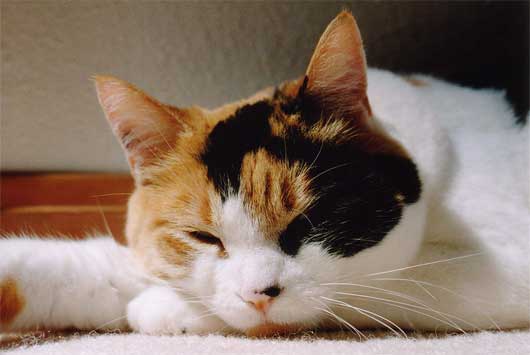The presence of sweat glands on the skin is an X-linked gene, meaning that it only exists on X chromosomes. The vast majority of men have only one X, so if they have the gene for sweat glands, they will have sweat glands all over, and if they don't have it, they won't. However, those of us with two X chromosomes (commonly known as females) could have one X with the sweat gene, and one X without it. Apparently if this is the case, during the development of the embryo, when the woman-to-be is just a handful of cells, each cell will randomly follow the genetic instructions of one X chromosome and dump the other one. These cells then multiply (a process called mitosis) resulting in patches of cells that have one gene, and patches of cells that have the other one.
Calico cats are the same way. Orange coloration and black coloration are carried on the X chromosome. Male (XY) cats only have one X, and therefore they carry the gene for only one of these colors. But female (XX) cats have two X chromosomes, and could have the genes for both colors. If they do, their cells will go one way or the other during embryonic development, multiply that color during mitosis, and produce a beautiful tricolor kitten. In a way, women like me are the calico cats of the human world. Only instead of having beautifully patterned fur, we have patchy sweat glands...but let's not overthink it. Just let me have my metaphor.
Interestingly enough, the calico cat is the official "Maryland State Cat." You learn something every day.
There are calico cats that are not female, but these are very rare. My grandmother's friend Laura Gould wrote a book spotlighting her own male calico, George, called Cats are Not Peas. These cats are usually XXY, a combination that is known as Klinefelter's syndrome in humans. Some people with Klinefelter's (not all, just some) identify themselves as intersex, like Callie, the fictional narrator of Middlesex. Callie is not XXY, but rather has a mutation on another chromosome that altered her development in the womb.
The name Callie is short for Calliope, one of the muses of Greek mythology. But for me the name conjures images of calico cats, especially those rare males, the gender benders of the feline world, displaying their genetics in tricolor glory for all to see.
(Keep in mind that my explanation is deceptively simple. Thanks to Marnie for explaining this all to me a few years ago. For more about the complexities of calico cat genetics, I think this site lays it all out pretty clearly.)



5 comments:
Aren't you giving away the mystery of gender identity if you reveal "just the tip"?
I think you should censor your father's comment.
did you like the end of the book? read virgin suicides. way way better. it's one of my favorite books ever.
"I liked this post, and I am especially impressed with your just the tip reference."
is that you, sad?
Post a Comment